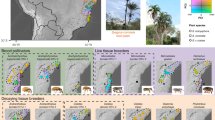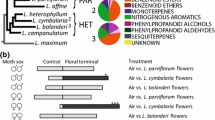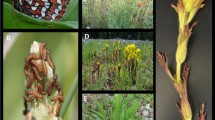Summary
The association between heliconiine butterflies and Passion flower vines is composed of three or more subassociations, in which each Heliconius species group feeds on a different Passiflora subgenus. The relationships are consistent with the adaptive zone hypothesis of Ehrlich and Raven, which would suggest that (1) species of the subgenus Plectostemma proliferated as a result of chemical barriers to herbivory, which created a herbivore-free adaptive zone in which speciation and diversification took place, and (2) species of the H. erato-charitonia group overcame these barriers and entered a competitor-free adaptive zone, in which they proliferated and speciated with those plants as hosts. The hypothesis that plant secondary chemicals were responsible for creating such barriers to herbivory was tested using heliconiine species as bioassays, in which reduced growth rates indicated presence of chemical barriers to feeding. Contrary to expectation, plants of the subgenus Plectostemma showed little or no chemical defense against any species of heliconiine caterpillar. In contrast many plants of the “primitive” subgenus Granadilla possessed significant chemical barriers against herbivory by heliconiine larvae, excepting those species in the H. numata-melpomene species group. I concluded that chemical barriers to feeding were not responsible for proliferation and diversification in the subgenus Plectostemma, nor did chemicals create a competitor-free “adaptive zone” in which the H. erato-charitonia species-group could proliferate and speciate. Chemical barriers may have been important in the evolution of the subgenus Granadilla-heliconiine association. I suggest that plant allelochemics are only one of many possible barriers to herbivory which can help create “adaptive zones” for plants and their herbivores, and that the patterns of butterfly foodplant specialization discussed by Ehrlich and Raven (1964) are not necessarily the result of biochemical adaptation and counteradaptation.
Similar content being viewed by others
References
Atsatt PR, O'Dowd DJ (1976) Plant defense guilds. Science 193:24–29
Benson WW, Brown KS, Gilbert LE (1976) Coevolution of plants and herbivores: Passion flower butterflies. Evolution 29:659–680
Berenbaum M (1983) Coumarins and caterpillars: A case for coevolution. Evolution 37:163–178
Boggs CA, Smiley JT, Gilbert LE (1981) Patterns of pollen exploitation by Heliconius butterflies. Oecologia (Berlin) 48:284–289
Brown KS (1981) The biology of Heliconius and related genera. Ann Rev Entomol 26:427–456
Brues, CT (1924) The specificity of food plants in the evolution of phytophagous insects. Amer Nat 58:127–144
Ehrlich PR, Raven PH (1964) Butterflies and plants: A study in coevolution. Evolution 18:586–608
Erickson JM, Feeny PP (1974) Sinigrin, a chemical barrier to larvae of the black swallowtail butterfly Papilio polyxenes. Ecology 55:103–111
Feeny PP (1976) Plant apparency and chemical defense. In: Biochemical interaction between plants and insects. Wallace J, Mansell R (eds) Recent Advances in Phytochemistry 10:1–40
Futuyma DJ, Slatkin M (1983) Coevolution. Sinauer, Sunderland, Mass
Gilbert LE (1971) Butterfly-plant coevolution: Has Passiflora adenopoda won the selectional race with heliconiine butterflies? Science 172:585–586
Gilbert LE (1975) Ecological consequences of a coevolved mutualism between butterflies and plants. In: Coevolution of Animals and Plants, Gilbert LE, Raven PH (eds) U. Texas Press, Austin and London, pp 108–140
Gilbert LE, Raven PH (1975) Coevolution of animals and plants. Univ. of Texas Press, Austin, Texas
Gilbert LE, Singer MC (1975) Butterfly Ecology. Ann Rev Ecol & Syst 6:365–397
Hull CH, Nie NH (1981) SPSS Update 7–9. McGraw-Hill, N.Y.
Killip EP (1939) American Passifloraceae. Field Mus Nat Hist, Botany 19:1–400
Janzen D (1982) Erblichia adorata Seem. (Turneraceae) is a larval host plant of Eueides procula vulgiformis Butler and Druce (Nymphalidae-Heliconiini) in Santa Rosa National Park. J Lepid Soc 37:70–78
Rosenthal G, Janzen DH (1979) Herbivores: Their interaction with secondary metabolites. Academic Press, N.Y.
Smiley JT (1978 a) Plant chemistry and the evolution of host specificity New evidence from Heliconius and Passiflora. Science 201:745–747
Smiley JT (1978 b) The host plant ecology of Heliconius butterflies in Northeastern Costa Rica. Ph. Dissertation, University of Texas at Austin, Austin, Texas
Sokal RR, Rohlf FJ (1969) Biometry. Freeman and Co. San Francisco
Author information
Authors and Affiliations
Rights and permissions
About this article
Cite this article
Smiley, J.T. Are chemical barriers necessary for evolution of butterfly-plant associations?. Oecologia 65, 580–583 (1985). https://doi.org/10.1007/BF00379676
Received:
Issue Date:
DOI: https://doi.org/10.1007/BF00379676




